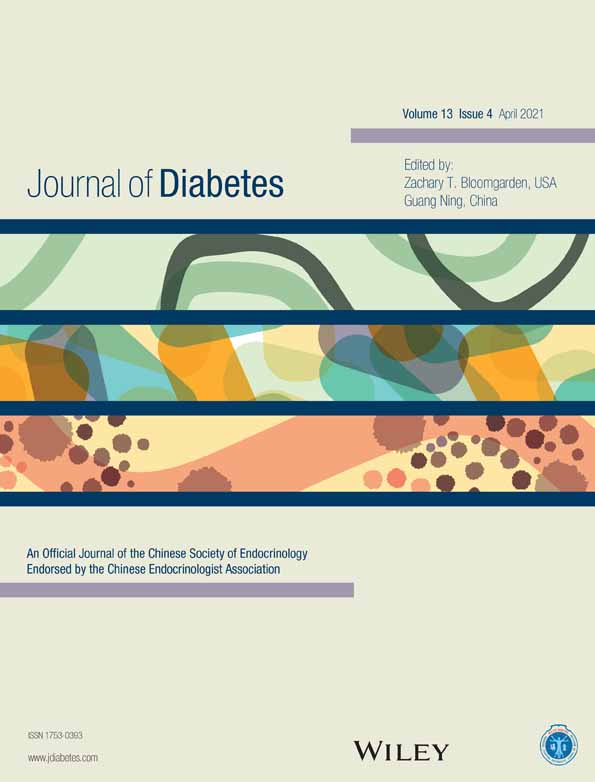Contribution of gestational diabetes mellitus heterogeneity and prepregnancy body mass index to large-for-gestational-age infants—A retrospective case-control study
妊娠期糖尿病的异质性和孕前体重指数对大于胎龄儿的影响——一项回顾性病例对照研究
Funding information: Bethune-Merck Diabetes Research Foundation, Grant/Award Number: G-X-2019-056; Clinical Research Award of the First Affiliated Hospital of Xi'an Jiaotong University, China, Grant/Award Number: XJTU1AF-CRF-2019-007; National Natural Science Foundation of China, Grant/Award Number: 81801459; National Science Foundation for Postdoctoral Scientists of China, Grant/Award Number: 2018M641001; Natural Science Foundation of Shaanxi Province, Grant/Award Number: 2019JQ069; Diabetes Research Foundation; Fundamental Research Funds for the Central Universities, Grant/Award Number: Z201806124; National Science Foundation
Abstract
enObjective
To study the associations between heterogeneity of gestational diabetes mellitus (GDM) subtype/prepregnancy body mass index (pre-BMI) and large-for-gestational-age (LGA) infants of Chinese women.
Methods
We performed a retrospective case-control study of 299 women with GDM and 204 women with normal glucose tolerance (NGT), using oral glucose tolerance test-based indices performed at 24-25 weeks of gestation. Women with GDM were classified into the following three physiologic subtypes: GDM with a predominant insulin-secretion defect (GDM-dysfunction), GDM with a predominant insulin-sensitivity defect (GDM-resistance), or GDM with both defects (GDM-mixed). We then used a binary logistic regression model to evaluate the potential associations of GDM subtypes and pre-BMI with newborn macrosomia or LGA.
Results
Women with GDM-resistance had a higher pre-BMI (P < 0.001), whereas women in the GDM-dysfunction and GDM-mixed groups had pre-BMIs comparable to the NGT group. In the logistic regression model, women in the GDM-mixed group exhibited an increased risk of bearing newborns with macrosomia and LGA, and women in the GDM-dysfunction group tended to have newborns with LGA after adjusting for pre-BMI and other potential confounders. Women who were overweight or obese prepregnancy manifested an increased risk of having newborns with macrosomia and LGA relative to normal-weight women, regardless of whether values were unadjusted or adjusted for all potential confounders. There was no significant interaction between GDM subtype and pre-BMI for any of the studied outcomes.
Conclusions
Heterogeneity of GDM (GDM-dysfunction and GDM-mixed) and prepregnancy overweight/obesity were independently associated with LGA in Chinese women. There was no significant interaction between GDM subtypes and pre-BMI for LGA.
摘要
zh目的
研究中国孕妇中, 妊娠期糖尿病(gestational diabetes mellitus, GDM)异质性分型及孕前体重指数分层(pre-pregnancy body mass index, pre-BMI)与大于胎龄儿(large-for-gestational-age, LGA)的关系。
方法
我们进行了一项回顾性病例对照研究, 我们分析了299例GDM孕妇和204例正常糖耐量(normal glucose tolerance, NGT)孕妇的临床数据。诊断GDM依据妊娠第24-25周的口服糖耐量试验结果, 按照生理特征将GDM孕妇分为以下三种亚型: 以胰岛素分泌缺陷为主要特征的亚型(GDM-dysfunction, GDM-dys), 以胰岛素敏感性缺陷为主要特征的亚型(GDM-resistance, GDM-res), 或以上两种特征缺陷均具备的亚型(GDM-mixed)。使用二元logistic回归模型分析GDM亚型/pre-BMI与巨大儿或LGA的潜在关联。
结果
GDM-res组的pre-BMI较高(P < 0.001), 而GDM-dys组和GDM-mixed组与NGT组的pre-BMI相当。在logistic回归模型中, GDM-mixed组生产巨大儿和LGA的风险增加, 而校正pre-BMI和其他潜在混杂因素后, GDM-dys组生产LGA的风险也增加。与正常孕前体重的孕妇相比, 无论是否调整潜在混在因素, 孕前超重/肥胖的孕妇生产巨大儿和LGA的风险均较高。同时, 本研究未发现GDM各亚型和各pre-BMI分组之间存在显著的交互作用。
结论
中国GDM孕妇中, 依据异质性分组, GDM-dys/GDM-mixed亚型和孕前超重/肥胖与LGA独立相关。GDM各亚型与pre-BMI各分组之间对于LGA的影响没有显著的交互作用。




